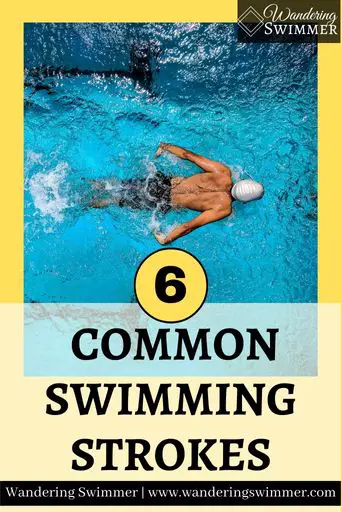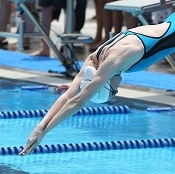In swimming, there are 6-8 common swimming strokes. Of these strokes, four are used specifically for competitive swimming. These are the front crawl (mainly referred to as freestyle), backstroke, breaststroke, and butterfly.
Related article: Swimming Basics to Get You Started
In addition to these four strokes, there are also the sidestroke and the elementary backstroke. These two strokes aren’t legal strokes in competitive swimming but can still be utilized in workouts.
Keep reading to learn about the common swimming strokes you can try at the pool!
Disclosure: This post may contain affiliate links, meaning we earn a small commission at no cost to you if you purchase something through one of our links. As an Amazon Associate, we earn from qualifying purchases. Please check out our disclosure page for more information.

Sidestroke
While not a stroke used in competitive swimming, the sidestroke is simple and relaxing. It’s not used or taught very often but for new swimmers or those wanting to find a place to start, this can be a good option.
Because the head stays above the water, this stroke is used by rescue swimmers due to the effectiveness and ease of the stroke to go long distances. US Navy Seals also use the sidestroke and another variant of the stroke in their training.
The Sidestroke Technique
This is the only stroke on this list that you’ll swim on your side, as the name suggests 🙂 Your head stays turned to the side so it’s out of the water, which makes it much easier to breathe.
To start, the side that you’re currently on will have your arm extended out in front of you and in the water (right for this example). While the other arm (the left) stays down at the side of your body so that your hand is by your hips. Keep your legs out behind you and together.
To take your stroke, bring the arm that’s extended in front of you (right arm) back down to your chest. This pulling motion will help pull you forward in the water. At the same time, your arm that’s at your side (left arm) will also come up to your chest. Your hands should meet near your chest.
More Content for You: What to Look for in a Women’s One Piece Swimsuit
Following this motion, bring your right arm forward again so that it’s extended out in front of you. Your left arm then pushes back down towards your hip, pushing you forward in the water.
For the leg/kick section of the sidestroke, your legs will kick on their sides in a scissor kick. This is very similar to the flutter kick that’s used in freestyle but performed on your side and with one knee bending.
Your right leg (for this example) will bend at the knee and kick up toward your bottom. As it kicks back down so it’s straight again, the motion gives you additional propulsion. At the same time, the left leg is bending up slightly towards your chest and then kicking back down so it’s straight.
Front Crawl or Freestyle
You may have heard of the front crawl and the freestyle stroke but you probably didn’t know that they’re often used interchangeably!
The difference comes down to the name and definition, as shown below.
- Freestyle: The name of a race/event in competitive swimming in which a swimmer can swim any (legal) stroke of their choosing
- Front Crawl: A style of swimming in which the swimmer faces downwards and moves their arms alternately in strokes (source)
The front crawl is one of the fastest swimming strokes utilized by swimmers and triathletes. Water polo players also use a variation of it. And it’s probably one of the more common swimming strokes you see at the pool as it’s so efficient to swim.
Freestyle Stroke Technique
In freestyle, the body faces the bottom of the pool with your face in the water. Your body doesn’t stay flat though. Instead, it rotates slightly from to side with each stroke that you take with your arms.
The head also rotates to breathe instead of lifting straight up, even though most people learn to breathe first with their head up. Breathing happens when the arm exits and recovers over the water. It’s a fast motion that requires swimmers to exhale before breathing so they can inhale during their stroke.
Related articles:
- Beginner’s Guide to Swimming Freestyle
- 7 Common Freestyle Stroke Mistakes
- 5 Flutter Kick Mistakes to Avoid
For the stroke portion of the front crawl, the arms move in alternate strokes. This means that the arms move opposite each other. When one arm is under the water, the other arm is above the water.
When it comes to the kick in freestyle, you may hear the word flutter kick and freestyle kick used interchangeably. However, they both refer to the kick that’s used in the front crawl. This kick happens when the legs move opposite each other. When one leg is kicking up, the other is moving down.
Elementary Backstroke
While elementary backstroke isn’t a legal stroke to use during competition at swim meets, it is a good starting stroke for learning backstroke. It can also be a good swimming stroke to use to catch your breath while still swimming.
Its simple technique makes it ideal for beginner swimmers. However, we will note that this swimming stroke is much easier if you can float well on your back. If you have trouble holding this position, you may struggle a little with this swimming stroke.
Technique for Elementary Backstroke
As the name implies, the elementary backstroke is swum on your back. Because you’re on your back, your head is out of the water and you can breathe as needed.
This swimming stroke starts with the hands coming up the armpits, almost like a monkey. Your hands should stay closer to the torso instead of being further away as they come to your armpits.
Once at your armpits, extend your arms out to your sides, like an airplane or the letter ‘T’. Your arms are then brought from this position back down to your sides. So that you look like a stick or a soldier.
More Content for You: 8 Best Swim Bags for Swimmers (And Water Enthusiasts)
For the kick, your legs move together with your arms in an inverted breaststroke or frog kick. Begin with your knees bending so your ankles drop into the water. Your legs will then spread slightly (like a frog kicking) before coming back together in one motion.
One of the ways this swimming stroke is taught to kids is by giving each stroke position a fun name, such as monkey, airplane, and soldier. We’ve also heard it called arrow, T, and stick!
Backstroke
The backstroke, as the name implies, is swum on your back. It’s one of the four competitive swimming strokes that can be used in swim meets. And next to elementary backstroke, is the only stroke swam on the back.
A lot of swimmers like this stroke because it’s easier to breathe, due to your head being out of the water. However, that doesn’t necessarily make it an easy swimming stroke for every swimmer.
More Content for You: 4 Ways to Prevent Swimmer’s Ear
When it comes to speed, backstroke can be the third or second fastest stroke – depending on the swimmer. Typically, the butterfly is faster than the backstroke at elite levels. But some swimmers may find that their backstroke is faster than their butterfly.
Backstroke Technique
As stated earlier, backstroke is swum while you’re on your back. Your head stays out of the water, except for when you roll over to complete a turn. Like freestyle, your body will rotate in time with your arms exiting the water.
Your arms move in alternating motions, moving opposite each other. When one arm is entering the water over your head, the other is exiting down by your hip. Swimmers gain movement and propulsion as the arm under the water is pushing the water down and away from them.
More Content for You: 6 Best Earplugs for Swimming
Similar to the freestyle kick, the backstroke uses a flutter kick, too. Your legs will move up and down in short, quick kicks. Your knees shouldn’t be bending too much or coming out of the water.
In many ways, backstroke is very similar to freestyle, only that it’s swum on the back and the arms bend a bit differently!
Breaststroke
One of the slowest competitive swimming strokes, breaststroke is either easy or difficult for swimmers. The timing can make it challenging, but getting to breathe on each stroke appeals to many newer swimmers.
Breaststroke is one of the first strokes taught to new swimmers, depending on the swim school or program. It may seem strange to start with this swimming stroke, but you tend to do parts of the stroke without realizing it!
You may also hear this referred to as the frog stroke in swim classes or school, as kids tend to find the name more fun 🙂
Technique for Breaststroke
For breaststroke, you’ll start on your stomach. This stroke alternates with your body in a flat or streamlined position while you’re horizontal in the water and at a steep incline. In some ways, it feels like bobbing because you’re going from horizontal to an incline and back again.
Your arms will need to move at the same time and should mirror each other as best you can. Start your breaststroke with your arms extended all the way out in front of you.
More Content for You: 8 Reasons Your Swim Cap Slides Off
From this position, your arms will press out and down into the water. They’ll make a circle just below the water’s surface (like they’re circling around the rim of a glass that’s right in front of you) and come back towards you.
Your hands should come up towards your chest and then come together in front of you. From there, bring your hands and arms forward to the extended position you started in.
The kick portion of the breaststroke has your legs also moving at the same time and mirroring each other. One of the best ways to remember this kick is to think of a frog kicking. Your legs are straight out behind you before you bend them at your knees.
Your heels should come up behind you and towards your bottom. From there, rotate your ankles/feet out and then bring your legs together. They should finish straight out behind you, just as they were when you started your kick.
To breathe, you’ll want to inhale as your body is rising out of the water. Right around the point when your arms are sweeping out through the water and coming back towards your chest.
Exhale as your face is entering the water to keep water from getting up your nose!
More Content for You: How to Count Laps in Swimming (with Tables)
Butterfly
The butterfly stroke (or fly, for short) is one of the most technical swimming strokes and can be the most difficult. It takes a lot of effort to swim and most beginner swimmers can only swim this stroke in short bursts or distances.
It’s the second or third fastest competitive swimming stroke. Depending on the swimmer, their butterfly may be faster than their backstroke or vice versa.
When it comes to the butterfly stroke, most people think of Olympian Michael Phelps.
Butterfly Stroke Technique
Like the other swimming strokes, the butterfly is swam on your front/stomach. The body undulates (moves in a smooth up-and-down motion), starting with the chest pressing down into the water and the hips/legs coming up.
Your head stays in a neutral position and doesn’t dive under the water when your chest is pressing down. While your head does submerge, it does not dive down into the water. Nor does it start the stroke. Instead, you should be pushing down with your chest instead of your head.
To breathe, it’s better to tilt your head forward so your chin skims over the water.
Most beginner swimmers though will need to raise their heads as they’re learning the butterfly motion and building upper body strength.
More Content for You: The Best 11 Kickboards for Swimming
The arm portion is similar to breaststroke, in that your arms move together and should be symmetrical. It’s best to think of the underwater portion of the butterfly stroke as an hourglass motion.
Your hands start in front of you and pull back towards your hips in the shape of an hourglass. They exit at the hips and your arms swing forward over the water. Your shoulders should also be shrugging forward, which will help your arms swing.
For the kick, the butterfly utilizes the dolphin kick.
As the name implies, it very much looks like a dolphin swimming/kicking through the water. You start the kick from your hips by pressing them down while your feet come up. The legs stay together throughout the whole kick and stay behind you.
Two Bonus Swimming Strokes
While less commonly used, these two bonus swimming strokes can be a way to challenge yourself during your next workout.
- Combat Side Stroke: This stroke derives from the sidestroke and is also used by military forces. It focuses more on a longer glide to improve distance per stroke. The arm motion is very similar to that of breaststroke but done on your side. And in between the scissor kick motion are a few flutter kicks. Your face is also in the water more, adding to the challenge
- Trudgen Stroke: Combining the scissor kick with a head-raised front crawl, the trudgen stroke is older than the sidestroke. It can be a bit awkward to get going and get a feel for the stroke but not having to put your face in the water is a benefit for some people
FAQ Regarding Common Swimming Strokes
What is the Most Common Swimming Stroke?
The front crawl (or freestyle) is probably one of the most common swimming strokes used. Not only is it the fastest stroke but it’s also very efficient. Swimmers can quickly cover a large distance with minimal effort compared to the other strokes
Which Stroke is the Hardest?
Honestly, it depends on who you ask! This is because what’s hard for one swimmer may be much easier for another.
However, we will admit that the butterfly stroke does require much more strength compared to the other swimming strokes. It’s also a complicated stroke, technique-wise, and the timing makes it hard to master.
When it comes to competitive swimming though, most swimmers will say it’s a toss-up between butterfly and breaststroke.
What Swimming Stroke Should I Learn First?
It’s probably best to start with the sidestroke or elementary backstroke if you have only basic swimming experience. From there, we suggest either the front crawl (freestyle) or the breaststroke.
More Content for You: The 10 Best Swim Fins for Swimmers
While breaststroke can be considered challenging, it’s one of the first strokes taught in some swim schools. And we believe it gets a bad reputation due to competitive swimming. In lap swimming and learning to swim, breaststroke can be easy.
Which Swim Stroke Burns the Most Calories?
The simple answer is that the butterfly stroke burns the most calories. It’s one of the most demanding strokes in swimming and requires the most effort.
Related article: How Many Calories Does Swimming Burn?
However, how many calories are burned while swimming is also determined by how fast you’re swimming, the intensity of your workout, and your workout duration.
Swimming a few laps of butterfly is great. But it won’t burn the same amount of calories compared to swimming freestyle for an hour straight. That said, trying to swim butterfly for lengths on end is not recommended. You can easily hurt yourself trying to do this.
In Closing
No one stroke is the same and everyone has a stroke that they’re more partial to. Just because you can’t swim one stroke doesn’t mean that you can’t swim. Instead, you may just need to find the stroke that works best for you!
As always, happy swimming!
Chevron
Bonus Content
How to Fix Common Swim Goggle Problems: Swim goggles. You love them but hate the problems that can come with them. Before you ditch your goggles for good, try some of these fixes.
8 Best Waterproof Fitness Trackers for Swimming: Finding the right fitness tracker for swimming can be challenging. We’ve rounded up the best 8 waterproof fitness trackers for you.

Want to Improve at the Pool?
Join swimmers and swim parents to receive my free newsletter and receive a free Swimming Glossary e-book as a thanks!
Every month you’ll receive tips and coaching to help you find success at the pool.
About

Chevron is a current competitive swimmer with almost 20 years of experience in the pool. And although she fell into the sport by accident in her high school years, she still trains daily and competes throughout the year. She’s committed to providing guidance to all levels of swimmers and believes that everyone should know how to swim.